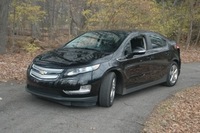2013 Chevrolet Volt Second Look Review By Steve Purdy
SEE ALSO: Chevrolet Buyers Guide - Reviews Specs and Prices 1997-2013
2013 CHEVY VOLT
Taking a second look
By Steve Purdy
TheAutoChannel.com
Michigan Bureau
 |
I’m just the opposite, a slow adopter of technology and rural dweller who drives seldom less than 100 miles in a day, with no political or practical agenda against gasoline use.
 |
The EPA makes an attempt at rating the mileage based on some
convoluted formula that tries to be consistent enough to compare to other
electrics and hybrids, and they’ve come up with 98-mpge (the
‘e’ standing for ‘equivalent’).
 |
With its little 9.3-gallon gas tank we have less than a 300-mile range before filling, but that will be of little concern for most Volt buyers. I filled twice this week with the gauge just below half and it took only about 5 gallons each time.
 |
 |
 |
Handling and performance are nothing to write home about but are perfectly adequate and well balanced. Acceleration is quite impressive on full throttle. An electric motor, as you probably know, gets its maximum torque right out of the hole. Ride and interior quietness will remind you of a larger car. With the well-designed front seats the average-sized person will find it comfortable.
Safety equipment on the Volt is impressive, with lots of airbags, chassis dynamics and structural rigidity. The Insurance Institute for Highway Safety has awarded Volt a “Top Safety Pick” designation and the National Highway Traffic Safety Administration awards 5-Stars (top level) in all but one category of crashworthiness. In spite of having the Navigation screen our test car did not have a backup camera. Seems like that would be a no-brainer to include that simple feature. (That wasn’t the only reason I backed into a low rising, stealthy yellow guard post this week, but it could have helped.) The rearview camera is optional as are lane departure warning, forward collision warning and park assist.
The lithium-ion battery and electric drivetrain components are warrantied for 8 years of 100,000 miles. The rest of the powertrain gets 5-year or 100,000 mile coverage. By the way, pay no heed to that burning battery flack of about a year ago. That resulted from improper storage at a testing facility. There have been no incidents like that in real world use.
Though sales of the Volt have been disappointing in the first couple of years it is mighty popular with those who know it best. For the second year Volt has topped Consumer Reports’ Owner Satisfaction Survey. I don’t know if that poll included our friend Walt, but I know what his vote would be.
ęSteve Purdy, Shunpiker Productions, All Rights Reserved



